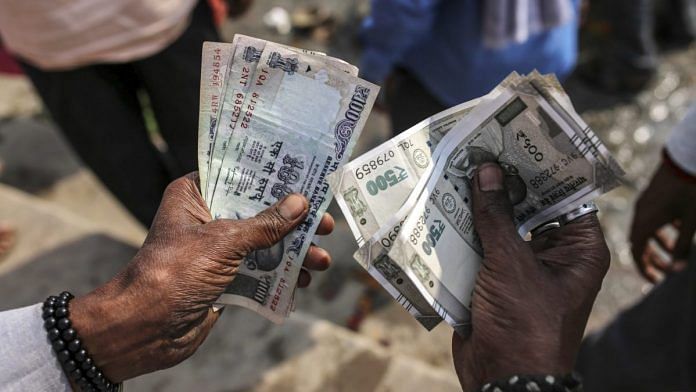Even ‘successful’ action by RBI to manage the value of the Rupee can only provide a short-term patch.
The fundamental reason for the drop in the value of the Rupee this year is that the currency has been propped up by the inflow of foreign funds based on the expectation of future returns. It is this flow of funds, and not the trade balance, which has allowed India to build up a reserve of foreign exchange and supported the Rupee. The other side of the coin, however, is that a reduction of confidence in India by foreign investors has led to lesser inflows of funds and growing outflows, causing depletion of reserves and a depreciation of the currency.
Efforts by the Reserve Bank of India to defend the Rupee, when unsuccessful, diminish official reserves and reinforce the negative investor sentiment, further accelerating the decline. The debate about what the RBI should do is, however, is beside the point. Even “successful” action by the RBI to manage the value of the currency can at most provide a short-term patch, but the underlying conditions for the country’s dependence on investor sentiment will go unaddressed.
Warren Buffett famously said: “You only find out who is swimming naked when the tide goes out”. This financial aphorism applies to countries as much as it does to companies or to individuals. An atmosphere of heightened general anxiety over the financial fragility of countries is one in which the “tide is going out” and leads some to have to run for cover (as Argentina and Turkey are doing now, taking emergency measures to attempt to restore investor confidence). However, only those who have been “swimming naked” have much to worry about.
Also read: India’s trade deficit biggest in five years, to worsen outlook for Indian rupee
Regrettably, India is one of these countries. The measure of being adequately clothed in finance is to have the ability to pay bills (most importantly, for imports). Without that ability, the country has to be dependent on the fluctuating sentiments of foreign investors.
Unfortunately, India has for years depended on the continuous inflows of foreign funds to pay its import bills. A sudden stop or reversal of such inflows, if sustained, would eventually necessitate cutting down on imports and investment, and accepting diminished economic growth.
There can be a cost to maintaining foreign inflows. Although private investment, unlike bailouts from the IMF, does not come with explicit ‘policy conditionalities’, it includes them implicitly. Successive governments have accordingly aimed to reassure foreign investors with well-aimed signals and policies.
India’s dependence on external financial confidence makes it fundamentally unlike China, as well as Korea, Taiwan, Singapore and other successful economies of east and southeast Asia. It makes it more akin to countries such as Brazil, Indonesia, South Africa or Turkey (collectively dubbed, with India, as the “Fragile Five” some years ago). China and other countries like it have pursued a policy that is export-oriented and manufacturing-centred, thereby generally covering their import bill and building up reserves over time. In contrast, the fragile countries depend on the bets placed by foreign investors on their futures because they have failed to develop into successful exporting countries, at least on the required scale. Countries in this situation may grow but face continuous threats that a downturn in foreign confidence will halt their progress.
Also read: Time to support rupee as overvaluation argument is seen to be easing
Efforts to please foreign investors with friendly policies, and robust economic growth based on domestic economic confidence can keep funds flowing in as long as the tide is favourable. Yet, these are not enough when the tide turns as a result of global factors. The most important such factor at present is the expected end of the “quantitative easing” policies that have caused cheap money to slosh around the globe, and financed much lending to and investment in the fast-growing emerging countries (of course, rising oil prices and other factors, including fears of increasing protectionism in the United States, also play a role). The export-oriented formula, “Make in India,” offers a correct prescription for India, as did Raghuram Rajan’s compatible import-substituting variant, “Make for India”. But the inadequate realisation of India’s productive potential is the ultimate basis of the ongoing vulnerability.
Also read: Modi govt wants RBI to step up efforts to support falling rupee
India’s failure to become a broad-based manufacturing exporter owes less to prices than to everything else that successful countries such as China do well and that India does not—adequate infrastructure, reliable and inexpensive power, an adequately healthy and educated workforce and many others. India’s remarkable success in global services exports masks this more basic failure of economic capabilities and social inclusion. Advice to the RBI and to the government to do nothing and allow the Rupee to slide confuses coping and cure. No one can predict if or when the fall of the Rupee will continue. What is clear is that it is the symptom and not the disease, and this must be not merely diagnosed but adequately treated.
The author is an Economist at the New School for Social Research, New York.




Great – I should certainly pronounce, impressed with your web site. I had no trouble navigating through all tabs and related information ended up being truly simple to do to access. I recently found what I hoped for before you know it at all. Reasonably unusual. Is likely to appreciate it for those who add forums or something, web site theme . a tones way for your customer to communicate. Excellent task.
Interesting and scathing read!
Obviously, most will love to disagree.